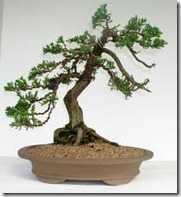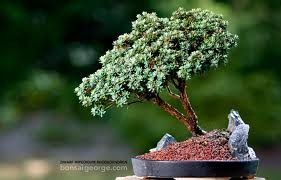 Like other creatures, life activities of plants vary depending on temperature,
Like other creatures, life activities of plants vary depending on temperature,
humidity, and sunshine. When making a bonsai, you must nurture and
manage the plant as its growth requires. For example, for plants growing in
areas with four distinct seasons, their yearly growths can be divided into the
following several stages.
Winter is when plants lay dormant. Plants store the nutrition produced in the
previous summer in their bodies and enter dormancy in this state. Generally
speaking, nothing but watering is necessary during this period. If your bonsai
tree is deciduous, you can simply keep it indoors or under the eaves. As you
can view the tree’s graceful shape during this period, this is the perfect time
for bonsai exhibition.
When winter is about to end and spring returns, plants come to life again.
During this period, you can prune the tree’s thick branches, fix the branches
with wires, or repot the plant. These works typically will damage the tree, but
at this stage there is still enough nutrition left in the tree, so the damage can
be kept at minimum. Moreover, when the plant becomes active again in
spring, the damages will be easily repaired. Repotting during this period can
make space for the roots’ growth in spring. If your tree is deciduous and has
been kept indoors during winter, you should take it outside the house.
As the weather gets warmer in spring, the plant’s growth becomes
increasingly active. Under the influence of the nutrition stored in the body,
new buds and roots grow simultaneously. The soil in the pot also dries up
easily now, so you need to frequently water the plant. After the new buds
appear and new leaves grow out, you can then prune them. For some species
of trees, you need to prune the new buds before the leaves grow out. Since
the tree grows rapidly during this period, you should closely monitor its
growth condition and prune any protruding or unwanted new buds.
Trees grow to the full in summer, and by this time they have depleted the
nutrition stored during the previous year. Meanwhile, leaves growing from the
stem produce nutrition via photosynthesis and the new nutrition is stored in
the plant’s body. During this period the tree uses up all the energy in its
growth, and its vitality is low. So you should only water the plant and avoid
other kinds of work. As the soil in the pot dries up quickly, watering is the
main task during this period. When the temperature rises, trees will also
enter a period of dormancy in order to protect themselves. In addition, high
temperature and high humidity can induce diseases and insect pests. Since it
is difficult to cure trees plagued by pests, everyday prevention is crucial.
In autumn, the growth of branches and leaves slows. As the plant needs
less nutrition for its growth, the rate of storage of nutrition produced in the
leaves accelerates in the body. This is the best time for the tree to replenish
its vitality. If you have a pine tree, it is also the time to create its shape by
wiring. As the temperature in the soil is higher than that on the surface of
the soil, the roots are still growing. So this period is also suitable for
repotting. After repotting, the roots will keep growing in the soil and firmly
take root there. To maintain sufficient vitality of the tree, you may consider
fertilizing it. After the red leaves of a deciduous tree fall, you can have a clear
view of the tree’s shape. So this is the perfect time to prune the small
branches. You should prune the protruding branches that disrupt the tree’s
shape and any other unneeded branches. Finally, the tree enters dormancy in
winter.

Deprecated: strpos(): Passing null to parameter #1 ($haystack) of type string is deprecated in /home/agriviek8Qv/agriviet.net/public_html/wp-includes/comment-template.php on line 2522